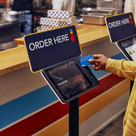If you needed a clearer indication that omnichannel is the future of retail, here you go: Amazon just bought Whole Foods for almost $14 billion, the retailer’s largest acquisition ever.
The e-commerce giant has yet to reveal what it will do with Whole Foods (many speculate it will integrate the grocery store with Amazon Prime and AmazonFresh). But this isn’t the company’s first physical-store rodeo. Amazon already has eight brick-and-mortar bookstores in the United States, with plans to open five more around the country before the end of the year.
At first glance, Amazon’s stores look just like regular bookstores — lines and lines of shelves showcasing the hottest titles. But these brick-and-mortar shops are fine-tuned machines, designed to create a seamless shopping experience across the company’s physical and digital channels. Omnichannel retail is all about “connecting the dots,” and Amazon’s bookstores excel at it. Here are a few ways they’re doing it.
You can pay with your app.
Want to buy a book? Just scan its code into your Amazon app. You still have to show the receipt to a store associate before you walk out the door (as opposed to Amazon’s grocery pilot, Amazon Go), but still, it’s a quick and convenient experience that gets customers interacting with multiple brand touchpoints at the same time.
There are no prices.
There are no prices on the books. To figure out how much something is, you have to take a picture of the book cover with the Amazon app, or walk over to a self-service price scanner. Then you see the regular Amazon price and the Amazon Prime price. The goal here is to understand customers: Based on what you bought (or didn’t buy), Amazon can target you with relevant content the next time you’re shopping online.
The store kind of looks like Amazon.com.
With any omnichannel retail strategy, it’s important that all channels feel cohesive. One way Amazon stores have accomplished that is with their display strategy. As opposed to many bookstores, which just showcase book spines, Amazon’s stores have all the book covers facing forward. This makes it a similar experience to shopping on Amazon.com.
It integrates social proof.
Many smart omnichannel retailers weave social media and online reviews into their brick-and-mortar shops. Amazon takes that one step further by using online reviews to determine its entire in-store product line. All the books in Amazon stores have at least a four-star rating on Amazon.com, and the books in the stores have collectively received over 1.7 million five-star reviews. That sort of social proof can lead to faster purchasing decisions — if you know a lot of people have already vouched for something, you’re more likely to buy it than to waffle.
Obviously, most businesses can’t do omnichannel retail on the scale of Amazon. But studying how the company uses its physical stores to drive digital sales can help give small businesses ideas for how to take their omnichannel strategy to the next level.
![]()











